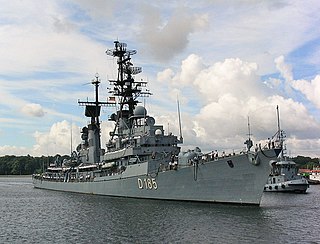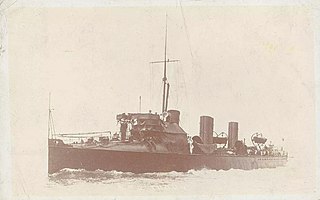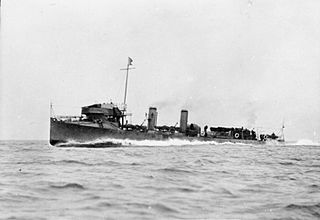
The Havock class was a class of torpedo boat destroyer (TBD) of the British Royal Navy. The two ships, Havock and Hornet, built in London in 1893 by Yarrow & Company, were the first TBDs to be completed for the Royal Navy, although the equivalent pair from J.I. Thornycroft, Daring and Decoy, were ordered five days earlier.

The River-class destroyer was a class of torpedo boat destroyer built for the Royal Navy at the turn of the 20th century, and which saw extensive service in World War I. The class introduced new features to destroyer design, placing a greater emphasis on seakeeping and endurance and less on a high maximum speed in good weather. All the ships were named after British and Irish rivers, and as such were the first Royal Navy destroyer class to be named systematically.

The Type 103 Lütjens class was the last class of destroyers in service with the German Navy. The ships were US Charles F. Adams-class guided missile destroyers but with some modifications to meet German requirements.

The C class as designated in 1913 was a heterogeneous group of torpedo boat destroyers (TBDs) built for the Royal Navy in the late-1890s. They were constructed to the individual designs of their builders to meet Admiralty specifications. The uniting feature of the class was a top speed of 30 knots, a "turtleback" forecastle and that they all had three funnels. The funnels were spaced equidistantly and were of equal height, but the central one was thicker.

The D class as they were known from 1913 was a fairly homogeneous group of torpedo boat destroyers (TBDs) built for the Royal Navy in the mid-1890s. They were all constructed to the individual designs of their builder, John I. Thornycroft & Company of Chiswick, to meet Admiralty specifications. The uniting feature of the class was a top speed of 30 knots and they all had two funnels.

The B class as designated in 1913 was a heterogeneous group of torpedo boat destroyers (TBDs) built for the Royal Navy in the late 1890s. They were constructed to the individual designs of their builders to meet Admiralty specifications, the uniting feature being a specified top speed of 30 knots (56 km/h) and four funnels, although the funnel spacings differed between ships. All "30 knotter" vessels with four funnels were classified by the Admiralty as the B class in 1913 to provide some system to the naming of HM destroyers. At the same time all "30 knotter" vessels with three funnels were classified by the Admiralty as the C class and those with two funnels became the D class.

HMS Spiteful was a Spiteful-class torpedo boat destroyer built at Jarrow, England, by Palmers Shipbuilding and Iron Company for the Royal Navy and launched in 1899. Specified to be able to steam at 30 knots, she spent her entire career serving in the seas around the British Isles.

The Acorn class was a class of twenty destroyers of the Royal Navy all built under the 1909-1910 Programme, and completed between 1910 and 1911. The Acorns served during World War I.

HMS Brazen was a B-class destroyer built for the Royal Navy around 1930. Initially assigned to the Mediterranean Fleet, she was transferred to Home Fleet in 1936. The ship escorted convoys and conducted anti-submarine patrols early in World War II before participating in the Norwegian Campaign in April–May 1940. Brazen later began escorting coastal convoys in the English Channel and was sunk in late July 1940 by German aircraft whilst doing so.

HMS Quail was a B-class torpedo boat destroyer of the British Royal Navy. She was launched by Laird Brothers, Birkenhead, on 24 September 1895. She served in home waters and the West Indies for several years, her robust structure proved by surviving at least one heavy collision. She served during the Great War, and was sold off after the hostilities end, on 23 July 1919. She gave her name to the four strong group of Quail-class destroyers.

The three Ardent-class torpedo boat destroyers were ordered by the British Admiralty on 12 October 1893 and served with the Royal Navy. Built by Thornycroft for a contract price of £110,520 for all three vessels, they displaced 301 tons fully laden, and were 201 feet 8 inches (61.47 m) long overall.
Four Quail-class destroyers served with the Royal Navy. These ships were all built by Laird, Son & Co. and were the first of the 'thirty knotters'.
Six Earnest-class destroyers served with the Royal Navy: Earnest, Griffon, Locust, Panther, Seal and Wolf. These ships were all built by Cammell Laird and were part of the class of 'thirty knotters'.
Two Spiteful-class destroyers served with the Royal Navy. These ships were both built by Palmers Shipbuilding and Iron Company Limited at Jarrow, and were part of the group of boats known as the 'thirty knotters'.
The Myrmidon-class destroyer was a class of two destroyers that served with the Royal Navy. Myrmidon and Syren were built by Palmers Shipbuilding and Iron Company as part of the group of boats known as the 'thirty knotters'.
HMS Brazen was a Clydebank three-funnel, 30-knot destroyer ordered by the Royal Navy under the 1895-1896 Naval Estimates. She was the fifth ship to carry this name since it was introduced in 1781 for a 14-gun cutter, sold in 1799.

HMS Recruit was a Clydebank three-funnel, 30-knot destroyer ordered by the Royal Navy under the 1895–1896 Naval Estimates. She was the fifth ship to carry this name since it was introduced in 1806 for an 18-gun brig-sloop, sold in 1822.

HMS Thorn was a Clydebank three funnel - 30 knot destroyer purchased by the Royal Navy under the 1899–1900 Naval Estimates. She was the second ship to carry this name since it was introduced in 1779 for a 16-gun sloop sold in 1816.

The Cricket class and following classes of coastal destroyers were a series of small torpedo boat destroyers (TBDs) intended to complement the Royal Navy's Tribal-class destroyers. The thirty-six vessels which broadly comprised this group actually consisted of several distinct classes, as each contractor built to their own designs, and even single contractor's designs evolved from year to year.














